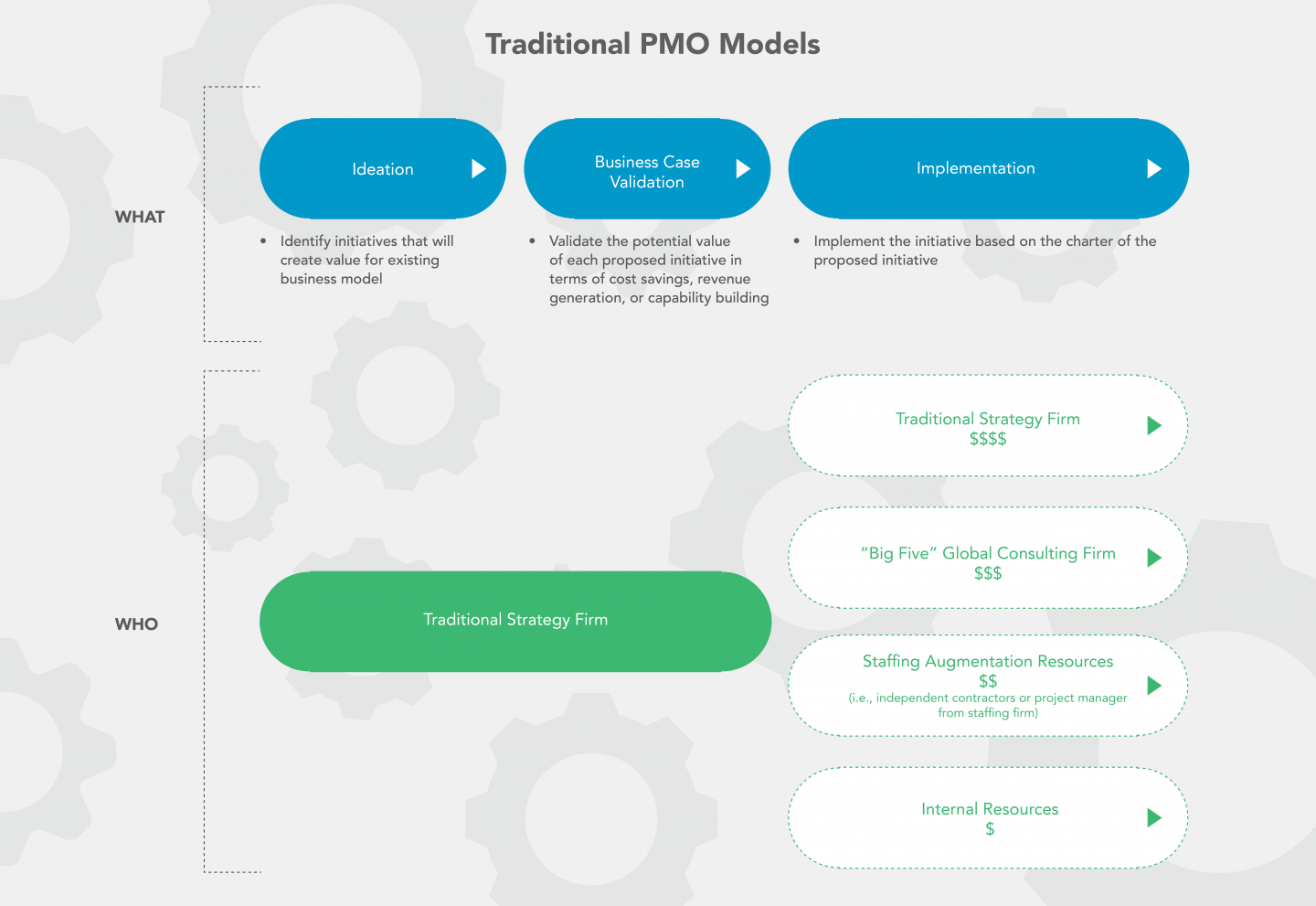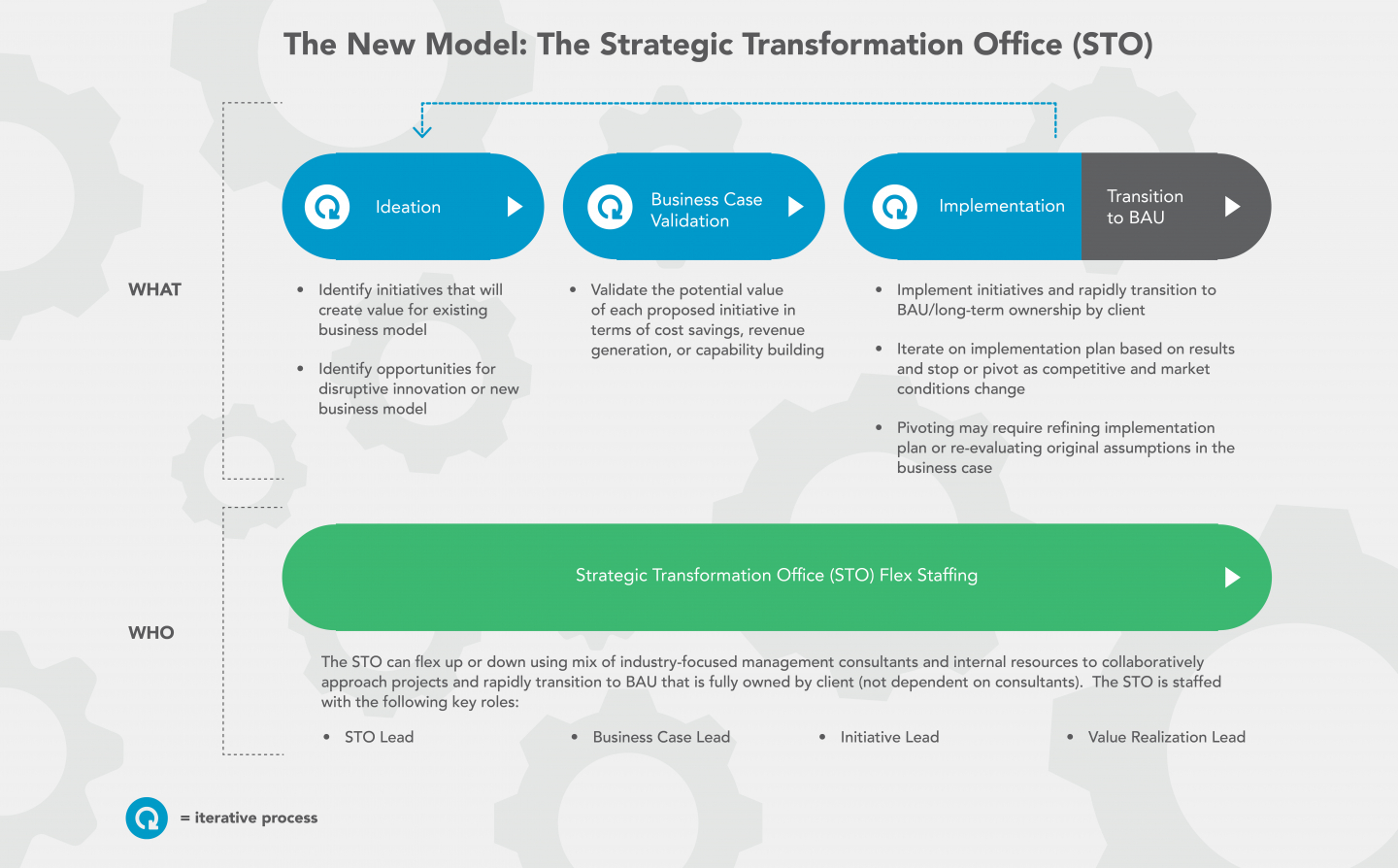Many healthcare companies have attempted to use Program Management Offices (PMOs) to navigate transformational change. Unfortunately, traditional PMO models have fallen short in producing either realistic business cases and/or quality execution. The limitations of these models are insufficient for today’s dynamic healthcare business environment. To overcome this, Vynamic has designed the Strategic Transformation Office (STO), a new model to help healthcare organizations develop and achieve pragmatic business cases, efficiently and flexibly deliver quality project outcomes, and ensure consistent business ownership from start to finish.
The healthcare industry is again abuzz with potential seismic changes to the landscape. Inevitably, all healthcare companies need to plan for multiple possible outcomes, and many will be faced with large, strategically important transformational initiatives. Strategic planning and execution, therefore, must be a nimble and ever-evolving capability – a company’s “point of the spear”. Looking back, it’s painfully clear that traditional Program Management Office (PMO) models have fallen short in producing both realistic business cases and quality project execution. To thrive in today’s healthcare industry, a new paradigm for driving change is emerging. Let’s first explore how healthcare companies typically manage portfolios of key projects.
In typical Program Management Office (PMO) models, there are three key stages: Ideation, Business Case Validation, and Implementation. These models often begin with hiring an expensive global strategy firm to do ideation – identifying and selecting projects with the greatest value potential. This is followed by business case validation with more detailed estimation and forecasting.

The strategy firm then hands off the business case to one of four types of organizations for implementation and benefits realization:
1. Traditional strategy firm
(same firm, typically handing off to a different team)
2. “Big Five” global consulting firm
3. Staff augmentation resources
(i.e., independent contractors or staffing firm resources)
4. Internal resources
Traditional PMO models are sub-optimal in today’s world for several reasons:
1. Companies overpay traditional strategy firms
As Harvard Business School professor Clayton Christensen noted in his article “Consulting on the Cusp of Disruption”, pure strategy work only accounts for about 20% of the traditional strategy firms today. Therefore, companies are likely overpaying for work if strategy and execution phases are not clearly defined.
2. Handoffs increase risk
Traditional strategy firm teams often roll off after business case creation. Big Five, Staff Augmentation, or internal resources usually begin onboarding after business case approval, squandering momentum and risking misunderstandings and costly delays*. Moreover, Big Five firms tend to bring fixed “pyramid” staffing approaches to PMO efforts, mixing inexperienced analysts into teams to offset the exorbitant rates of senior managers or partners.
3. Plans always change during implementation
When implementation doesn’t match business case expectations, Staff Augmentation and Big Five firms can be hamstrung by a lack of context for the original business case objectives and intent. This can result in overspending through rework when recasting the business case is required. Alternatively, using internal resources can put projects at risk if resources are not fully dedicated to the PMO or if they do not have the right skill-set to drive detailed implementation plans.
4. Lastly, traditional strategy firms often provide resources that are not industry-focused
This fresh perspective isn’t inherently bad, but it often leaves blind spots or soft spots in a business case. Additionally, because the traditional strategy firm’s high costs force them to be parachuted in for a short duration, they may short-change stakeholder engagement and may not have the right mindset, temperament, or context for making decisions in the long-term best interest of the organization.
Underwhelming benefits realization, high costs and timeline delays all call for a fundamentally better way. Vynamic recommends a new model: The Strategic Transformation Office (STO). As the name implies, the STO focuses on strategic high ROI initiatives, whereas traditional PMO models often hold a broad portfolio of projects. The STO is built for speed and agility with a client first mindset – ensuring that companies maintain control of their most strategic projects. Each STO is designed to fit into the existing enterprise for as long as it’s needed. It draws from healthcare industry focused resources starting with clients, and adding management consultants only where needed. This ensures a level of pragmatism needed to achieve actual savings, incremental top-line revenue growth and/or capability building. If management consultants are used, it’s not in a traditional way – successful realization of business case benefits and full transition back to the business are the goals, focused on long term client success at every turn.
The STO is typically staffed with a mix of client and consulting resources, filling four key roles:
STO Lead
Oversees the entire portfolio of projects to ensure the pipeline is filled with high-value projects, implementation is leading to benefits, staffing levels are optimized, and change management is embedded organizationally. Vynamic recommends that a client always plays this pivotal role to eliminate bias in determining mix of internal vs. consulting resourcing as well as to manage the long-term relationship with and to provide updates to senior leadership.
Business case lead
Drives ideation and validation of potential projects that can be weighed in terms of strategic priority and financial value. They source ideas from all levels of the organization, driven by business need.
Initiative lead
Works with key stakeholders to create detailed plans and drive a project through implementation (benefits realization) phase; the Initiative Lead then rapidly transitions the work to business resources so it becomes part of business as usual (BAU).
Value realization lead
Works across the portfolio of STO initiatives to set up key performance indicators (KPIs) that align with each initiative’s business case. This embeds a structured process for quantifying and measuring attained value.
Through years of experience working with numerous world class healthcare clients, Vynamic sees several advantages of the STO over the Traditional PMO model:
Speed and agility – By using experienced, healthcare industry-focused resources, projects move faster and can adapt to change more easily.
Better “momentum management” – The STO is established before business cases are created, is in place well into implementation, and eliminates unnecessary hand-offs. Cross-functional stakeholders win in a model where relationships are strong, and trust is high.
Pragmatic, achievable business cases – STO resources are continuous from ideation through to benefits realization, so there is much greater incentive to build business cases that can be achieved.

In a dynamic healthcare industry landscape, a robust strategic transformation capability is becoming a vital part of any thriving healthcare company. The Strategic Transformation Office (STO) model offers a flexible, cost-efficient, client centric approach using only experienced healthcare industry resources. Given the countless examples of overinflated business cases and underwhelming project execution associated with traditional PMO models, it’s time for a new model to emerge.
Citations:
The cost of delays related to #2 above vary for each project, potentially ranging from $ thousands to $ millions, but can be estimated by calculating the difference in cost between types of resources x duration of delay + loss of sales or productivity. As it relates to #3 above, the cost of implementing a project with an outdated strategy and having to scrap it later is even more severe.

Vynamic, an Inizio Advisory company, is a leading management consulting partner to global health organizations across Life Sciences, Health Services, and Health Technology. Founded and headquartered in Philadelphia, Vynamic has offices in Boston, Durham NC, New York, and London. Our purpose is simple: We believe there is a better way. We are passionate about shaping the future of health, and for more than 20 years we’ve helped clients transform by connecting strategy to action.
Through a structured, yet flexible delivery model, our accomplished leaders work as an extension of client teams, enabling growth, performance, and culture. Vynamic has been recognized by organizations like Great Place to Work and Business Culture Awards for being leaders and innovators in consulting, company culture, and health. Visit Vynamic.com to discover how we can help transform your
organization or your career.
 Mindy McGrath
Mindy McGrath
Are you ready for the Inflation Reduction Act? Assess your readiness and adapt strategies to thrive amid regulatory changes in the healthcare...
Read more Aminah Fawad
Aminah Fawad
In M&A, success hinges on managing the most valuable asset: people. This insight explores why a people-centric approach is crucial for post-deal su...
Read more Colleen Lawlor
Colleen Lawlor
Bring clarity to complexity and ensure a successful Alliance Launch with a cohesive culture, streamlined processes, and efficient asset management.
Read more